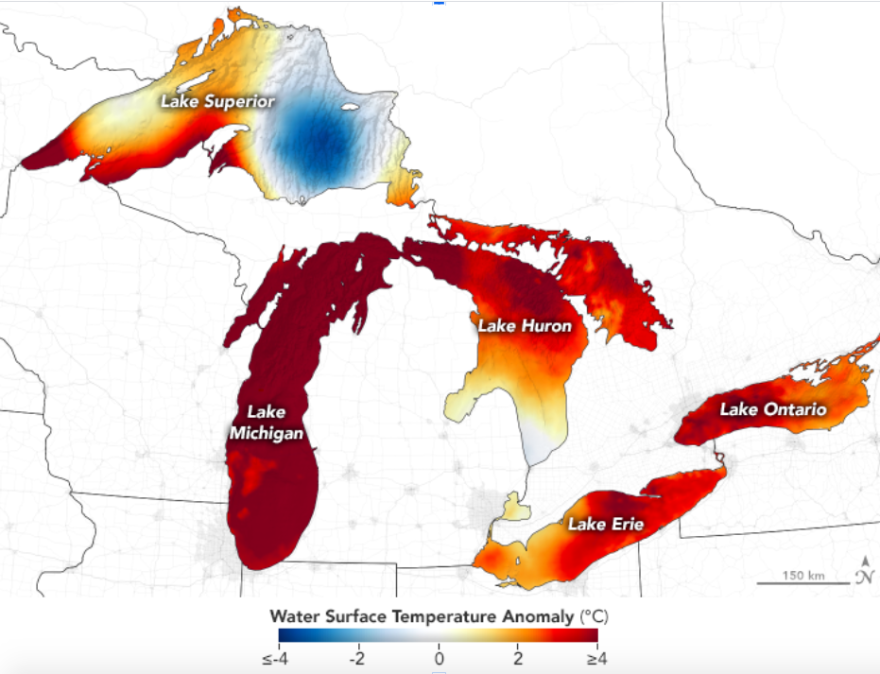If you took a dip in Lake Michigan in early July you might have noticed the water felt pretty nice.
At 75 degrees, the lake was warm — nearly 10 degrees warmer than normal. Since then, the lake has cooled off slightly, but its surface temperatures are still above-average, and climbing.
The hot spell in the Great Lakes had been brewing for months and follows larger climate trends in the region. Winter seeded the first ingredient, when mild temperatures and below-average ice coverage left the lake warmer than normal. That effectively gave the lake a jump start on summer, says Eric Anderson, a scientist at the NOAA Great Lakes Environmental Research Laboratory in Ann Arbor.
“When air temperatures start to rise and solar radiation gets stronger, that energy coming into the lake can go into warming up the water, as opposed to working on melting ice,” Anderson says.
Then, at the beginning of July, a heat wave engulfed much of the Midwest and brought little wind over Lake Michigan. “With these calm winds, the lake wasn’t getting stirred up as much as it normally does,” says Anderson.
Without wind action, a layer of warm water settled on top of the lake. “It’s a little bit like salad dressing,” describes Sarah Green, a chemistry professor at Michigan Technological University. “Your warm water is acting like the oil it floats on the top. So it takes a big storm to mix it up.
That salad-dressing separation happens every year, when warm water floats on top of cooler water. It’s called stratification. But this year, the separation kicked in early. And then, for weeks, the layers of water didn’t mix.
Today, temperatures in Lake Michigan are still four to five degrees above normal--- some of the highest they’ve been in the last five years. But they’re not as high as they were at the beginning of the month, in large part thanks to cooler, windier weather in recent weeks.

John Lenters, a scientist at the Great Lakes Research Center at Michigan Tech says to think of the lake like a bathtub. Its warm surface layer is like a sheet of cellophane floating on top. If you blew on it, the cellophane would end up on the other side of the tub. “That’s basically what happens on these lakes,” Lenters says.
When wind blows away the warm surface layer, a shot of cooler water rises from below, explains Lenters. “That’s what happened in Lake Superior and other lakes as well.”
Right now, it’s too early to say how temperatures will play out for the rest of the year. If the warm water sticks around, aquatic life could run into trouble. We could see more algal blooms, says professor Alan Steinman, an aquatic ecologist at Grand Valley State University in Muskegon.
Warm, stagnant surface water can also stress out fish. That’s because when the lake stratifies — when that top warm layer stays put — oxygen doesn’t get mixed down to the bottom of the lake.
This year’s warm spell probably hasn’t caused those sorts of problems, says Steinman. But we might see more of those issues in the future. “If it’s something that recurs year after year, then we’re going to see some changes,” he says. “We’re certainly seeing changes from other factors associated with climate change that are going on right now.
Scientists predict the layer of warm water on Lake Michigan’s surface will form earlier and last longer in coming years. They also expect more rainfall and flooding — like the record-high lake levels we’re seeing now.
“Now that doesn’t mean it’s going to happen again next year, but it will probably happen a couple of years after that,” says Lenters. “Climate change is often described as loading the dice. When you load the weather dice, you start to see certain patterns show up more frequently than they used to.”
This year, Lake Michigan still has another few weeks to heat up before the water starts to cool. There’s still plenty of time to swim, and for the lake to reach another record high before the summer is out.


